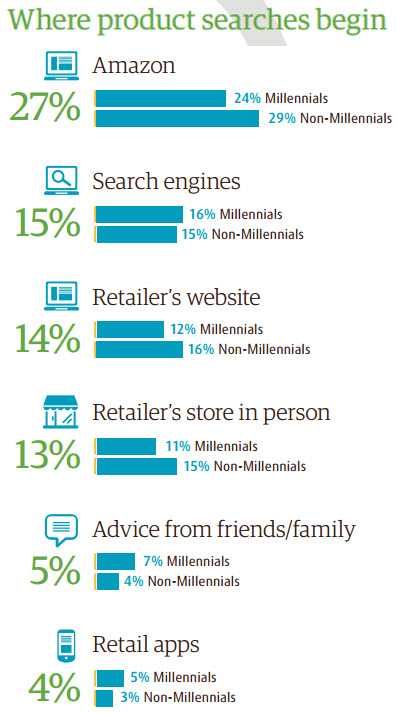When searching for products online, Amazon and Google are the leading places to start, according to a study released this week. Thirty-eight percent of shoppers polled reported starting their shopping search on Amazon, with 35 percent searching on Google first.
Males seeking a new pair of shoes online might therefore search on Amazon or Google in relatively similar numbers for “men’s dress shoes,” for example.
An additional 21 percent of shoppers report starting at brand or retailer sites. These shoppers are more likely to start their search at a retailer such as Nordstrom or on a brand site like Allen Edmonds. The final six percent of shoppers start their shopping experience on other ecommerce marketplaces like eBay.
The “Mapping the Path to Purchase” study was conducted by PowerReviews, a leading provider of review, rating, and question-and-answer services. One thousand thirty-four online shoppers participated in the study, in April 2016. Because a ratings and reviews provider conducted the survey, the questions and results summary is geared toward the value of ratings and reviews. However, there is still some interesting information that ecommerce marketers can use in their natural search strategies.

Most online shoppers begin their product shopping journey at Amazon or Google. Source: PowerReviews “Mapping the Path to Purchase,” June 2016.
Interestingly, PowerReview’s findings were consistent with another larger study of shopping behavior conducted by comScore, in June 2016, titled “UPS Pulse of the Online Shopper.” comScore’s report contains shoppers that begin their journey both online and offline, where PowerReviews focuses on online shoppers only.
comScore found that 27 percent of its respondents began their shopping journey at Amazon, and 15 percent at a search engine. These were the two largest buckets of combined online and offline shopping activity, with retailer’s website (14 percent), retailer’s store in person (13 percent), advice from families and friends (5 percent), and retail apps (4 percent) rounding out the top responses.

Most shoppers begin their journey online at Amazon or a search engine. Source: comScore’s “UPS Pulse of the Online Shopper,” June 2016.
The numbers for search engines are markedly lower in comScore’s findings. It would be interesting to see if and how the results would change if both test groups were asked the same question regarding where their online shopping journeys begin.
Regardless, the most obvious conclusion for both reports is that Amazon search and natural search optimization are the largest individual opportunities to increasing the likelihood that shoppers will see and choose your products instead of your competitors’.
Focusing on online shoppers only, ecommerce businesses with a strong natural search presence and that also leverage the Amazon Marketplace have an opportunity to influence up to 73 percent of shoppers in their particular category, according to the PowerReviews survey.
Take the men’s’ dress shoes example again. If your site dominates the rankings for searches in Google for “men’s dress shoes,” approximately 35 percent of the shoppers in that category could be exposed to your brand in the Google search results. If you also sell your men’s dress shoes on Amazon, and your Amazon search optimization is strong, you have the opportunity to influence 38 percent of the shoppers in your category. Added together, that’s potentially 73 percent of the online shoppers in your category. And by comScore’s measurement, it’s 42 percent of shoppers who begin the process both online and offline.
Optimize Twice
Either way, to intercept these shoppers at the beginning of the shopping journey, optimize for natural search on two different places.
First, optimize product detail pages in Amazon. Product data and descriptions are your opportunity to shine in Amazon. Leave no data field empty, and use the words people use to describe your products when writing your product title and description.
There’s a lot more to it, like pricing, reviews, and other factors. But the basics of data and content optimization are an important place to start. Read my summary of opportunities to optimize Amazon product content at “SEO: Optimizing Product Content on Amazon.” My review of Amazon keyword research tools will help as well.
Second, optimize your ecommerce site on the search engines. The easiest place to start is content optimization, but technical optimization to your site’s infrastructure and architecture can also help. Start with my “SEO 101” guide to learn more. It covers everything from “What Is SEO?” to “Keyword Research Planning” and “Content Optimization.” To go a bit deeper, look into my “SEO 201” series, which starts with “Technical Rules” and ends with “Using Structured Data.”




